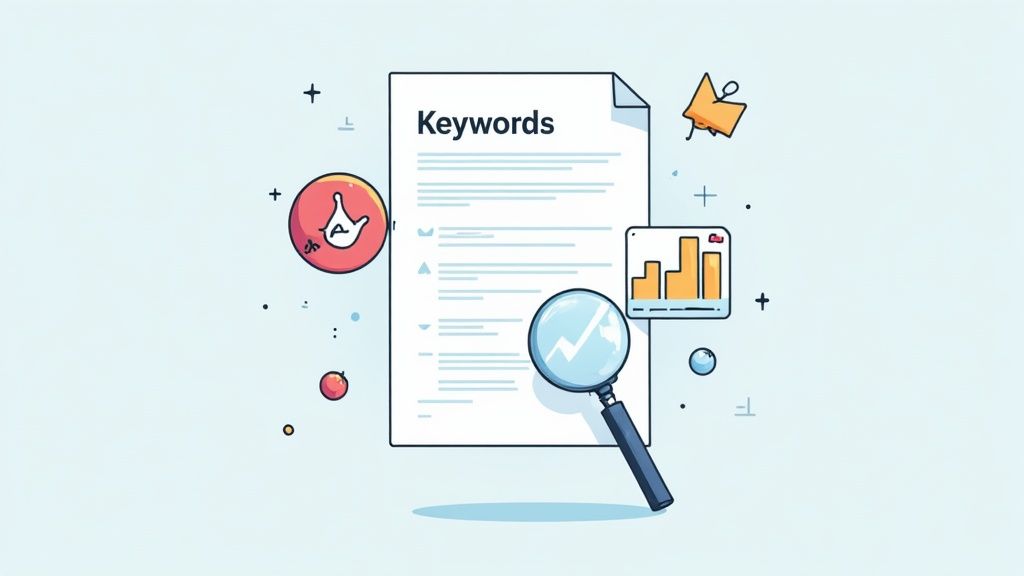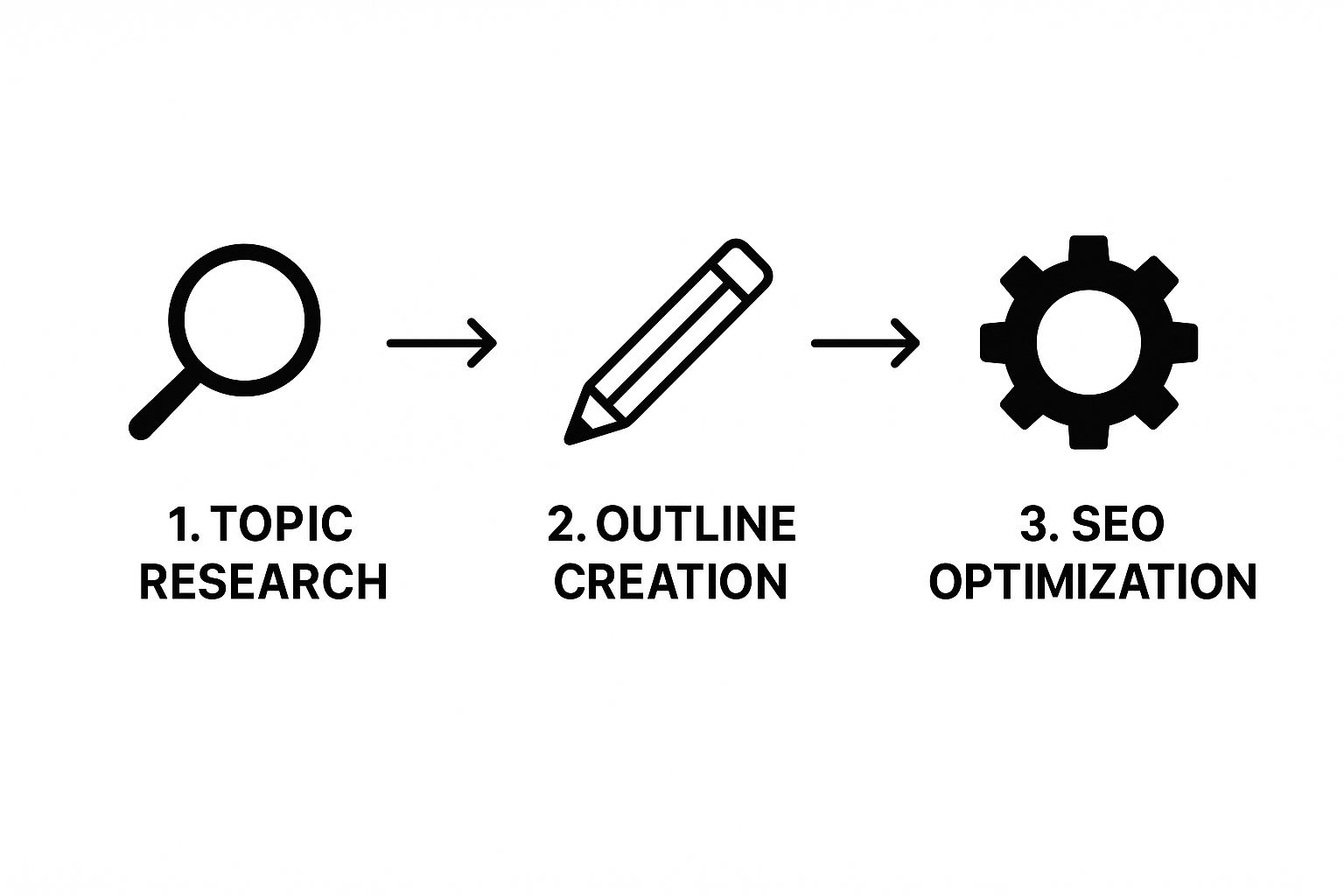In a digital world dominated by fleeting paid ads and noisy social media feeds, organic search remains the unshakable foundation of a smart growth strategy. Sustainable traffic doesn’t come from buying your way to the top; it comes from earning the trust of people actively looking for your solutions.
Unlike someone passively scrolling past a sponsored post, an organic visitor is on a mission. They have a specific problem or question and have turned to a search engine for answers. When your site appears, you’re not an interruption—you’re the solution. That’s a powerful first impression that builds lasting trust.
Why Organic Traffic is Your Most Valuable Asset
Think of it like this: a paid ad campaign is like renting a storefront. The moment you stop paying rent, your business disappears from the street. A strong organic presence, however, is like owning the building. A single, well-optimized article can attract qualified visitors for months, or even years, after you hit “publish.” It’s an asset that appreciates over time.
The data backs this up. Organic search is projected to drive over 53% of all website traffic by 2025. With 68% of online experiences beginning with a search engine, a weak organic strategy means you’re invisible to the majority of your potential customers. You can explore how these industry benchmarks should inform your approach.
Building a solid foundation for this kind of traffic comes down to mastering a few core principles.
We’ve broken down the essential components of a winning organic strategy below. Nailing these pillars is non-negotiable for achieving consistent, long-term growth.
Core Pillars of Organic Traffic Growth
| Pillar | Actionable Objective | Practical Examples & Key Activities |
|---|---|---|
| Keyword & Intent Research | Understand exactly what your audience searches for and why. | Identify specific, long-tail keywords. Analyze search intent (is the user learning, comparing, or buying?). Map keywords to each stage of the customer journey. |
| High-Quality Content | Create the single best answer to a user’s problem. | Write in-depth “how-to” guides, publish original case studies, and create detailed product comparisons. Ensure every piece is uniquely valuable. |
| On-Page SEO | Optimize every page to rank higher and earn more clicks. | Craft compelling titles and meta descriptions. Use a logical heading structure (H1, H2, H3). Optimize image alt text. Naturally weave in target keywords. |
| Technical SEO | Ensure your website is fast, secure, and easy for search engines to crawl. | Improve page load speed. Ensure mobile-friendliness. Fix broken links. Implement a logical site structure and use a sitemap. |
| Authority & Linking | Build your site’s credibility and guide users to relevant content. | Earn backlinks from reputable websites. Create a smart internal linking structure that connects related articles and distributes ranking power. |
Each pillar supports the others. World-class content is useless if your site has poor technical SEO, and a technically perfect site won’t rank without content that matches user intent. It all works in concert.
Actionable Takeaway: Organic visitors aren’t just numbers; they are prospects with a clear purpose. Because they are actively seeking your solutions, they are far more likely to engage, convert, and become loyal customers.
How AIWU Automates Your Organic Workflow
Let’s be practical—managing all this manually is a recipe for burnout. Juggling keyword research, content creation, on-page optimization, and internal linking can overwhelm even the most dedicated teams. This is precisely the problem AIWU was built to solve. It automates the repetitive, time-consuming tasks so you can focus on high-level strategy.
Here’s how AIWU solves the biggest bottlenecks in organic growth:
- Problem: Scaling Content Creation. Solution: AIWU generates dozens of SEO-optimized articles and blog posts in bulk. This gives you a consistent stream of fresh content to target new keywords without draining your team’s resources.
- Problem: Perfecting On-Page SEO. Solution: AIWU automatically handles tedious but critical on-page elements—titles, meta descriptions, image alt tags, and more—ensuring every piece of content is perfectly primed for search engines from the start.
- Problem: Building a Smart Site Structure. Solution: The Smart Crosslinking feature is a game-changer. It intelligently builds internal links between your posts, creating a logical site architecture that boosts your SEO, improves user navigation, and keeps visitors on your site longer.
By integrating AIWU into your process, you aren’t just creating content faster. You’re deploying a highly efficient, automated engine designed from the ground up to drive organic traffic.
Find Keywords Your Audience Actually Uses

Let’s get one thing straight: effective SEO isn’t about tricking Google. It’s about deeply understanding what your audience types into their search bars when they have a problem you can solve.
Too many businesses chase high-volume, generic keywords—a surefire way to get lost in the noise. Real growth comes from uncovering the specific questions, pain points, and needs of your ideal customers.
The first step is to shift your focus from what you think they search for to what they actually do. A great starting point is conducting thorough market research. This isn’t an optional step; it’s the foundation that reveals the real language your customers use, which is pure gold for your content strategy.
Target Long-Tail Keywords to Capture High-Intent Traffic
Speaking of gold, the real treasure lies in long-tail keywords. These are longer, more specific search phrases—typically three or more words—that reveal clear user intent.
Real-world example: Someone searching for “shoes” is just browsing. But someone searching for “best waterproof trail running shoes for wide feet” is ready to buy.
Long-tail keywords have lower search volume, but they convert at a much higher rate because you’re meeting people at their precise moment of need. They are also far less competitive, giving you a realistic chance to rank and attract traffic that turns into actual business.
Actionable Tip: Map your keywords to the customer journey. People ask different questions at different stages. Your content strategy must cover everything from “what is…” (informational) to “best X vs. Y” (comparison) and finally, “buy now” (transactional) searches.
A Practical Scenario: A Local Landscaping Business
Imagine you run a local landscaping company. Targeting the generic term “landscaper” is a waste of effort. Instead, let’s create content that maps to a real homeowner’s journey.
- Awareness Stage (Problem-focused): The homeowner looks at their patchy lawn and thinks, “I need to fix this.” They might search for: “how to fix a patchy lawn” or “low-maintenance backyard ideas.”
- Your Action: Create helpful blog posts that solve these problems.
- Consideration Stage (Solution-focused): They’ve decided to hire a professional. Now they’re searching for: “best landscaping companies near me” or “cost to install a new patio.”
- Your Action: Publish service pages, case studies, and transparent pricing guides.
- Decision Stage (Purchase-focused): They are ready to hire someone. Their searches become hyper-specific: “get a quote for patio installation in [Your City]” or “emergency tree removal [Your Neighborhood].”
- Your Action: Ensure your contact and quote pages are perfectly optimized for these high-intent terms.
By creating content for each stage, you build trust and become the obvious choice when it’s time to make a decision.
Build Topic Clusters Effortlessly with AIWU
Manually brainstorming hundreds of keywords, mapping them to the customer journey, and then writing all that interconnected content is a monumental task.
This is where a tool like AIWU provides a significant competitive advantage. Instead of guessing, you can use it to build out complete topic clusters—a proven SEO strategy where a central “pillar” page is supported by numerous related “cluster” articles.
AIWU helps you automate this entire process:
- Discover Related Keywords: It instantly finds dozens of long-tail variations and questions related to your core services, eliminating guesswork.
- Generate Cluster Content: It drafts all the supporting blog posts and pillar pages you need to establish deep topical authority.
- Automate Internal Linking: The Smart Crosslinking feature intelligently connects all these articles, signaling your expertise to Google and making your site a magnet for relevant traffic.
This isn’t about working harder; it’s about deploying a smarter, automated strategy to own the entire conversation around your niche.
Create Content That Google and Humans Love

You’ve identified your keywords. Now comes the most critical part: creating content that actually deserves to rank. In an internet overflowing with generic, rehashed articles, the only way to capture Google’s attention is to publish something significantly better than the competition.
We’re talking about content so helpful and well-presented that it’s irresistible to both search engines and human readers.
This isn’t just about answering a question. It’s about delivering a complete solution—solving a problem so thoroughly that your reader has no reason to click the “back” button.
The Anatomy of a High-Performing Blog Post
Think of your content as a product. The information is the core feature, but the packaging—its readability and structure—is just as important. Even the most brilliant advice will be ignored if it’s buried in a wall of dense text.
Here are the non-negotiable elements for every piece of content you publish:
- A Magnetic Headline: Your title is your one chance to earn the click. It must promise a clear benefit and spark curiosity. “Landscaping Tips” is boring. “7 Low-Effort Landscaping Hacks to Add Instant Curb Appeal” gets the click.
- A Compelling Introduction: The first paragraph has one job: hook the reader. Acknowledge their problem and promise a clear, actionable solution. Get straight to the point and prove they’re in the right place.
- A Scannable Structure: People don’t read online; they scan. Use clear H2 and H3 subheadings to break up your content and create a logical flow. Think of them as a roadmap for your reader’s eyes.
- Visual Breaks and Readability: Nothing kills engagement faster than a intimidating block of text. Use short paragraphs, bullet points, numbered lists, and relevant images to create white space and make your information easy to digest.
This structure isn’t just for humans. Search engines rely on headings and lists to understand the hierarchy and main topics of your page. Nail the formatting, and you make it easier for them to rank you.
How to Create Superior Pillar Content
To truly dominate search results, you must go beyond standard blog posts and create pillar content. These are comprehensive, authoritative guides that cover a core topic from every angle. The goal is to create the single best resource on the internet for that subject.
So, how do you make your content undeniably superior to what’s already on page one?
The key for 2025 and beyond is to focus on depth, relevance, and user experience, rather than chasing sheer traffic volume. As AI reshapes search, businesses that invest in brand authority and genuinely valuable content will be the ones who succeed.
This is especially true when you realize that a staggering 70% of all clicks on Google go to the top five organic results. This winner-takes-all reality means “good enough” is a recipe for failure. With organic search traffic predicted to dip as AI-powered search gets better, creating standout content is your best defense.
Here are three actionable ways to make your content stand out:
- Incorporate Unique Data or Research: Conduct your own surveys or analyze public data sets. Offering fresh insights that can’t be found elsewhere is a powerful way to build authority.
- Feature Expert Insights: Interview experts in your industry. Including unique quotes adds credibility and a perspective your competitors can’t easily replicate.
- Provide Actionable Examples & Case Studies: Don’t just tell people what to do—show them. Use real-world case studies and step-by-step walkthroughs that readers can actually apply.
The AIWU Workflow for Scalable Quality
Creating pillar content sounds like a massive undertaking, and traditionally, it is. This is exactly where AIWU transforms your workflow. Instead of staring at a blank page, you can generate a comprehensive, well-structured first draft in minutes.
The AIWU workflow puts your content and SEO on autopilot, handling the heavy lifting of outlining and initial writing.
This frees you to focus on the high-impact tasks only a human can perform: injecting your unique brand voice, layering in proprietary data, and adding expert insights that make your content truly exceptional. With AIWU, you can scale content production without ever sacrificing quality.
Sharpen Your On-Page and Technical SEO
Even the most brilliant content will collect digital dust if search engines can’t find, crawl, and understand it. This is where the foundational work of on-page and technical SEO comes in. It’s the essential plumbing that allows your great content to flow to your audience.
Think of it this way: your content is the star performer, but your website’s technical health is the stage crew. If the lights are out and the mics are dead, no one will see the performance, no matter how brilliant it is. A slow, confusing, or broken website actively sabotages all your hard work.
The On-Page SEO Checklist: Your Pre-Publish Ritual
On-page SEO involves optimizing the individual elements on your page. It’s your most direct way to signal to Google what your content is about. Mastering these details creates a series of small wins that add up to a huge impact on your rankings.
For every single page you publish, run through this checklist:
- Compelling Title Tag: This is your headline in the search results. Keep it under 60 characters, include your primary keyword, and write a benefit-driven title that begs to be clicked.
- Intriguing Meta Description: This is your 160-character sales pitch in the search results. While not a direct ranking factor, it must expand on the title’s promise and entice users to choose your link.
- Logical Header Structure: Use one—and only one—H1 tag for your main title. Break up content with H2s for major sections and H3s for sub-points. This creates a clear hierarchy for both users and crawlers.
- Descriptive Alt Text: Every image needs alt text. It makes your site accessible and gives search engines context about the image, which helps reinforce your page’s topic.
Nailing this process ensures every page is perfectly tuned for search. For platform-specific advice, our guide on Mastering SEO on WordPress offers more detailed, actionable tips.
Polishing Your Technical Foundation
Beyond individual pages, your site’s overall technical health is critical. A great place to start is with a solid guide to search engine indexing, which explains how search engines find and organize your content in the first place.
This infographic simplifies the core workflow for creating optimized content that ranks.

This simple flow—from research to optimization—is the absolute backbone of any successful organic traffic strategy.
Actionable Takeaway: You can’t just write great content and hope for the best. On-page SEO tells Google what a page is about, while strong technical SEO ensures Google can actually find, understand, and rank it effectively.
With AIWU, you can put much of this tedious work on autopilot. As it generates content, it handles on-page elements like titles and alt text. Better yet, its Smart Crosslinking feature automatically builds a powerful internal link structure for you, saving hours of manual work while boosting your site’s authority and helping search engines navigate your content efficiently.
Navigate the New Era of AI Search

The ground is shifting beneath our feet. Google’s AI Overviews and the Search Generative Experience (SGE) are not just another algorithm update—they represent a fundamental change in how people access information. If you’ve seen a dip in traffic recently, you’re not alone.
The old game of simply “answering questions” is becoming obsolete. Why? Because AI can now do that instantly, right on the search results page.
This new reality is causing significant disruption. While organic search still accounts for roughly 33% of all website traffic, early data shows Google’s AI results can slash traffic by anywhere from 18% to a staggering 64% for some websites. Relying solely on old-school SEO tactics is now a high-risk strategy.
So, what do you do when an AI intercepts your traffic? You stop trying to beat it at its own game and start doing what it can’t.
How to Future-Proof Your Content Strategy
The old playbook was to create content that answered a specific search query. The new model is to create content that AI can’t easily summarize and replicate. This means moving beyond generic guides and focusing on content that is rich with real human experience and unique insights.
Your best defense against AI-driven traffic loss is to double down on what makes your brand uniquely human.
- Showcase Firsthand Experience: Tell your stories. Share detailed case studies. Talk about your real-world successes and, more importantly, your failures and the lessons learned. An AI cannot replicate your journey.
- Publish Proprietary Data: Run your own surveys, analyze your internal data, and publish original research. Content built on data nobody else has is a magnet for authority and high-quality backlinks.
- Provide Deep, Nuanced Expertise: Go beyond surface-level answers. Tackle complex, controversial topics that demand critical thinking, a strong opinion, and strategic insight—all things AI struggles with.
Expert Insight: In this new landscape, your brand is your most valuable SEO asset. A trusted brand with a clear point of view and a loyal following will win because people will start searching for you by name, bypassing the AI gatekeeper entirely.
The AIWU Advantage in an AI-Powered World
Adapting to this new reality requires a smarter workflow. You need to produce this high-quality, experience-driven content at a scale that keeps you relevant. This is where a tool like AIWU becomes a strategic partner, not just a content generator.
Instead of asking AI to write another generic article, use AIWU to build the scaffolding for your unique content. Let it handle the tedious parts, like the initial research and outline for a deep-dive case study or a data-heavy report. This frees you up to do the one thing that truly matters: injecting your human insights, weaving in your brand’s voice, and showcasing your unique data.
It’s about evolving from a technical SEO checklist to a full-blown brand strategy. For a deeper analysis of this shift, check out Neil Patel’s insights on the Google Reset and winning in a world of AI. Your expertise and firsthand experience are the only assets that are truly future-proof.
Common Questions About Growing Organic Traffic
Even with a solid strategy, questions are bound to pop up once you start implementing. Let’s tackle some of the most common ones to give you the clarity you need to move forward confidently.
How Long Does It Really Take to See SEO Results?
This is the million-dollar question. The most honest answer is this: SEO is a marathon, not a sprint.
While you might see small wins in a few weeks—like a keyword jumping a few positions—real, meaningful growth in organic traffic typically takes 4 to 12 months to materialize. That’s a wide range because the timeline depends heavily on a few key factors:
- Your Website’s Age & Authority: An established domain with a history of quality content will see results faster than a brand-new site starting from scratch.
- Industry Competition: Ranking for “personal injury lawyer” is a much tougher and longer battle than ranking for “hand-knitted dog sweaters.”
- Consistency & Effort: This is the biggest factor you control. The frequency at which you publish high-quality content and build authoritative links directly impacts your timeline.
Think of the first few months as building your foundation. Once that flywheel starts spinning, momentum builds on itself, delivering the sustainable, long-term traffic you’re aiming for.
Should I Create New Content or Update Old Posts?
The best strategy is to do both. A healthy content plan requires a mix of creation and optimization.
Creating new content is essential for targeting new keywords, expanding your topical authority, and reaching new audience segments. It’s how you enter new conversations within your niche.
However, updating old content is one of the most efficient SEO tactics available. Refreshing an existing article with new data, better examples, and improved on-page SEO can deliver a significant ranking boost for a fraction of the effort it takes to create a new post.
Practical Action: Apply the 80/20 rule. Spend 80% of your time creating new, high-value content and dedicate the remaining 20% to identifying and refreshing your best-performing older posts for a quick and powerful win.
Are Backlinks Still Important For Organic Traffic?
Yes, absolutely. High-quality backlinks from relevant, reputable sites remain one of Google’s top three ranking factors. They act as “votes of confidence” from other websites, signaling to search engines that your content is valuable and trustworthy.
The game has changed, however. It’s all about quality over quantity. A single, powerful link from an industry-leading blog is far more valuable than hundreds of low-quality, spammy links. It’s a non-negotiable part of modern SEO. For many sites, a strong backlink profile is also a critical step toward monetization, a topic we cover in our guide on the easy steps to get AdSense approval.
Your best strategy is to focus on creating “link-worthy” assets—such as original research, ultimate guides, or free tools—that people will want to reference and share naturally.
Ready to stop guessing and start growing? AIWU automates the tedious parts of SEO—from content creation and on-page optimization to smart internal linking—so you can focus on strategy. See how it can transform your organic traffic at https://aiwuplugin.com.

